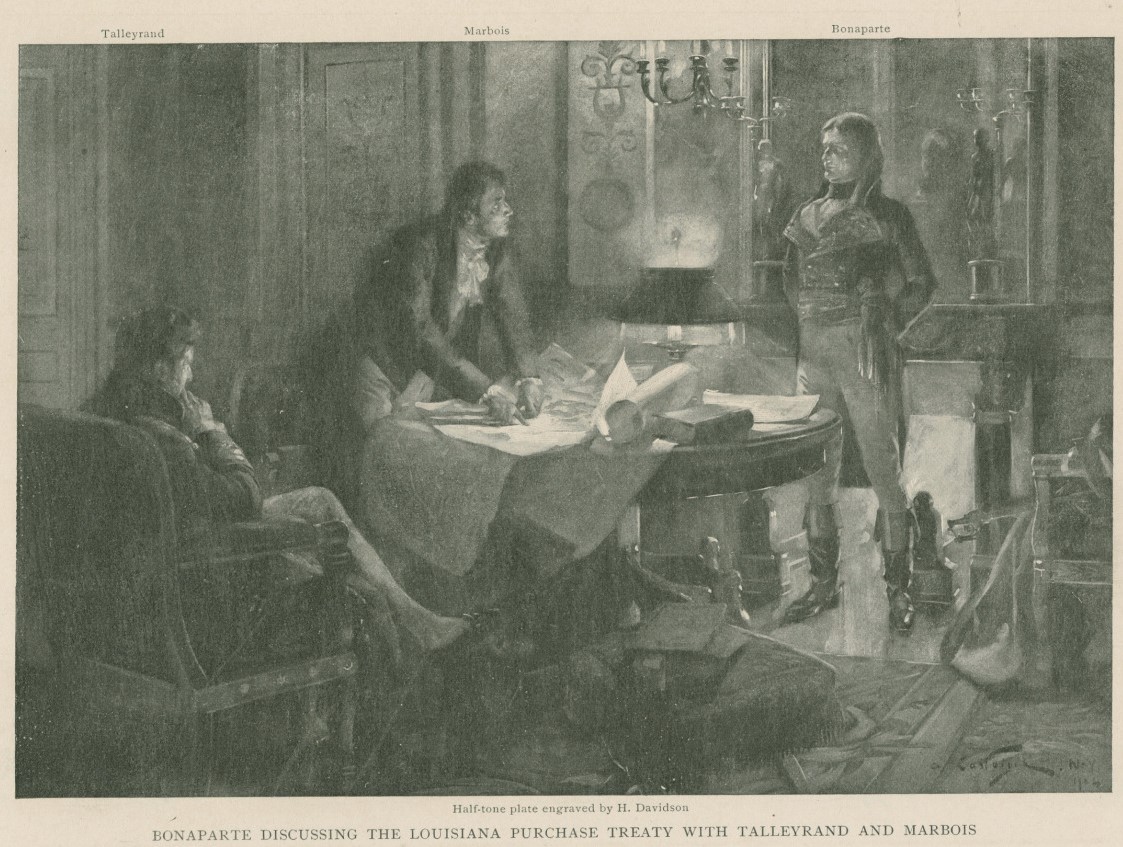Third Treaty of San Ildefonso
The Third Treaty of San Ildefonso secretly transferred control of colonial Louisiana from Spain to France.

The Historic New Orleans Collection
Bonaparte Discussing the Louisiana Purchase Treaty with Talleyrand and Marbois. Andre Castaigne (artist) and H. Davidson (engraver)
In the Third Treaty of San Ildefonso Spain secretly traded the colony of Louisiana to France on October 1, 1800. In return for New Orleans and the vast territory west of the Mississippi, King Carlos IV of Spain received an Italian kingdom for his wife’s family. By transferring the colony of Louisiana to France, the treaty was one significant link in a chain of events that led to the Louisiana Purchase in 1803. France’s acquisition of Louisiana was part of First Consul Napoleon Bonaparte’s vision to rebuild the French empire in the Americas. In the United States news of the treaty sparked fears that France would deny American access to the Mississippi River. This concern prompted President Thomas Jefferson to seek to obtain New Orleans through diplomatic means. French possession of Louisiana proved short-lived. Following the defeat of the French army by Black rebel troops in Saint-Domingue, Bonaparte decided to sell the entire territory of Louisiana to the United States.
Spain Retrocedes Louisiana to France
When Spain acquired the territory from France in the 1762 Treaty of Fontainebleau, Louisiana served as a strategic barrier between Spain’s prized colony of Mexico and British North America. Almost four decades later most of the land outside of New Orleans remained sparsely populated by colonists, and Louisiana’s eastern neighbor had declared itself the United States. American geographic and economic expansion put Spanish holdings at risk. Louisiana officials nervously watched as a growing number of Anglo-Americans moved west of the Appalachian Mountains, desperate to use the Mississippi River for trade.
By 1800 Spain’s participation in wars spawned by the French Revolution left the kingdom drained. Although the Spanish crown hesitated to return Louisiana to an increasingly powerful France, the sale eased Spain’s financial burden and offered better protection for Mexico. The 1801 Convention of Aranjuez confirmed the terms of the Treaty of San Ildefonso and created the Kingdom of Etruria in Italy for the nephew of Spain’s queen. Spain also received a written pledge that France would not sell or trade Louisiana to another nation.
Bonaparte’s Imperial Vision
Regaining French possession of Louisiana supported the ambitious plans of Napoleon Bonaparte, who came to power following a 1799 coup. Bonaparte envisioned a renewed French empire in the Caribbean and North America. Louisiana would supply food, wood, and other necessities to French islands producing sugar and coffee with enslaved labor. The French colony of Saint-Domingue formed the centerpiece of Bonaparte’s plan. Since 1791, however, Saint-Domingue had been engulfed in revolution, beginning with a major insurrection by enslaved people. By 1800, slavery had been abolished and revolutionary leader Toussaint L’Ouverture governed the colony. Threatened by L’Ouverture’s authority on the island, Bonaparte sent forty thousand soldiers and sailors under the command of his brother-in-law General Charles Emmanuel Leclerc to regain control of Saint-Domingue in 1802.
American Reaction to the Treaty
Rumors of the Treaty of San Ildefonso reached the United States in 1801. While American diplomats tried to confirm the treaty’s existence, the Jefferson administration considered the potential impact of the treaty on the United States. Access to the Mississippi River and the right of deposit in New Orleans was critical for Americans, especially for otherwise isolated citizens living west of the Appalachians. In 1795 the United States gained permission from Spain to ship goods downriver and export them from New Orleans. France could revoke that privilege—a loss that the Jefferson administration believed could threaten the union. If the US government proved unable to maintain Americans’ right to navigate the Mississippi, the western states could break away and form their own nation. With this fear in mind, President Jefferson initiated a diplomatic campaign to acquire New Orleans from France in 1802.
The Louisiana Purchase
Jefferson entrusted negotiations with France over the US acquisition of New Orleans to ambassador Robert R. Livingston. These negotiations became more urgent after October 1802 when a Spanish official in New Orleans briefly withdrew the US right to freely use the port for trade. Americans in the Mississippi Territory, Kentucky, and other western states threatened to take New Orleans by force. In response Jefferson sent James Monroe as special envoy to Paris to assist Livingston with the purchase of New Orleans.
The fall of 1802 also marked a turning point in Bonaparte’s campaign to regain control of Saint-Domingue. Leclerc and his troops had initial success, capturing L’Ouverture in July. By October, however, French forces suffered major losses against the rebel army led by Jean-Jacques Dessalines. French soldiers also died from yellow fever, including Leclerc in November. Bonaparte recognized that success in Saint-Domingue was unlikely without committing significantly more resources. Within a year Dessalines’s troops forced the French army to withdraw.
Without Saint-Domingue, Bonaparte had no use for Louisiana. In April 1803 he instructed French Foreign Minister François Barbé-Marbois to sell the entire territory of Louisiana to the United States. Although Livingston and Monroe were only authorized to purchase New Orleans, the diplomats agreed to the deal. In the resulting Louisiana Purchase, the United States bought over 800,000 square miles of land for $15 million.
Transfer of Power in Louisiana
The Treaty of San Ildefonso briefly returned Louisiana to France, but the Spanish continued to govern the territory until late 1803. Pierre Clement Laussat, the official sent by Bonaparte to take over administration of Louisiana, arrived in New Orleans in March 1803. Laussat formally governed the territory for three weeks, overseeing a peaceful transfer from Spain to France on November 30 and from France to the United States on December 20, 1803.
